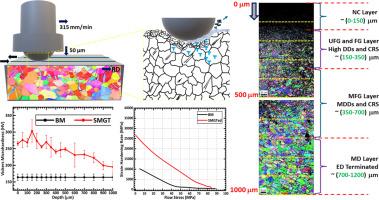Effect of surface mechanical grinding treatment on the microstructural evolution and mechanical properties of commercially pure titanium
IF 2.9
Q2 MATERIALS SCIENCE, MULTIDISCIPLINARY
引用次数: 0
Abstract
The evolution of microstructure and mechanical properties of commercially pure titanium subjected to surface mechanical grinding treatment has been investigated to decipher the underlying deformation mechanisms of gradient structure formation during SMGT. SMGT specimens demonstrated obvious grain refinement and an exceptionally increased fraction of low-angle grain boundaries as well as a multi-banded gradient structure with a heterogeneous twin structure. The SMGT process resulted in the formation of a 1000 µm thick gradient structure layer on both sides showing a significant improvement (BM: 164 HV; surface MH: 265 HV improved by 62 %; sub-surface MH: 309 HV improved by 88 %) in microhardness at the surface and sub-surface region, accompanied by a gradual decrease to the center of the specimen. Tensile testing of the SMGT specimens shows a 33 % (BM YS: 327 MPa; SMGT YS: 436 MPa) increase in the yield strength and a 31 % (BM UTS: 392 MPa; SMGT UTS: 514 MPa) increase in UTS with a significant reduction in ductility compared to the virgin sample. The mixed fracture modes (ductile fracture in CG/ML layer; brittle fracture in GS layers) observed in fractographic results suggest the stress-strain partitioning, gradual transition of mechanical properties throughout the gradient thickness, and complex interactions between different banded regions of the sample with heterogeneous microstructure. The strengthening and microstructural evolutions observed in this investigation are collectively attributed to SMGT-induced plastic deformation, compressive residual stress, grain refinement, increased fractions of LAGBs, and cDRX (continuous dynamic recrystallization) facilitated by localized heating (due to sliding friction of tool and specimen).

表面机械磨削处理对工业纯钛显微组织演变和力学性能的影响
研究了工业纯钛经表面机械磨削处理后的显微组织和力学性能的演变,以揭示SMGT过程中梯度结构形成的潜在变形机制。SMGT试样晶粒细化明显,低角晶界比例异常增加,呈多带状梯度组织,呈非均质孪晶组织。SMGT工艺导致两侧形成了1000µm厚的梯度结构层,其性能得到了显著改善(BM: 164 HV;表面MH: 265 HV提高62%;亚表面MH: 309 HV在表面和亚表面区域的显微硬度提高了88%,并逐渐降低到试样的中心。SMGT试样的拉伸试验结果表明,SMGT试样的拉伸强度为33% (BM YS: 327 MPa;SMGT YS: 436 MPa),屈服强度提高31% (BM UTS: 392 MPa;SMGT UTS: 514 MPa)与原始样品相比,UTS增加,但延展性显著降低。混合断裂模式(CG/ML层韧性断裂;在GS层中观察到的脆性断裂)表明应力-应变分配,力学性能在整个梯度厚度上的逐渐转变,以及样品中不同带状区域之间复杂的相互作用,具有异质组织。在本研究中观察到的强化和微观组织演变共同归因于smgt诱导的塑性变形、压缩残余应力、晶粒细化、lagb分数增加以及局部加热(由于工具和试样的滑动摩擦)促进的cDRX(连续动态再结晶)。
本文章由计算机程序翻译,如有差异,请以英文原文为准。
求助全文
约1分钟内获得全文
求助全文
来源期刊

Materialia
MATERIALS SCIENCE, MULTIDISCIPLINARY-
CiteScore
6.40
自引率
2.90%
发文量
345
审稿时长
36 days
期刊介绍:
Materialia is a multidisciplinary journal of materials science and engineering that publishes original peer-reviewed research articles. Articles in Materialia advance the understanding of the relationship between processing, structure, property, and function of materials.
Materialia publishes full-length research articles, review articles, and letters (short communications). In addition to receiving direct submissions, Materialia also accepts transfers from Acta Materialia, Inc. partner journals. Materialia offers authors the choice to publish on an open access model (with author fee), or on a subscription model (with no author fee).
 求助内容:
求助内容: 应助结果提醒方式:
应助结果提醒方式:


